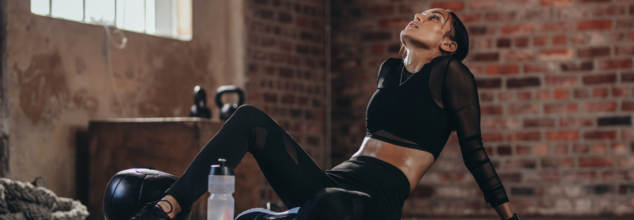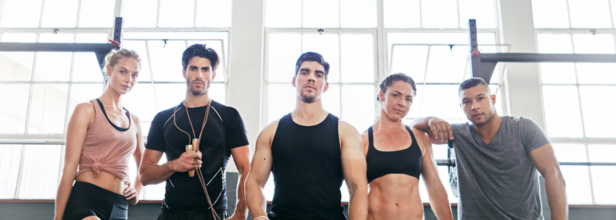- Health Conditions A-Z
- Health & Wellness
- Nutrition
- Fitness
- Health News
- Ayurveda
- Videos
- Medicine A-Z
- Parenting
- Web Stories
5 Strange Feelings People Get While Exercising And What Your Body’s Trying To Tell You

Credits: Canva
We're all familiar with what to expect from a good workout- muscle ache, pounding heart, perhaps the pleasure of a runner's high if we're fortunate. But what about those odd, surprise sensations that creep upon you halfway through your sprint or in that final set of squats?
We all have strapped on sneakers and hit the road for the first time in years with a humble expectations, perhaps burning lungs, a little jelly legs, and a good reminder that school cross country was a distant memory. What people weren't prepared for, 15 minutes into the run, was a sudden toothache—yes, tooth pain, in the middle of cardio.
That run was the beginning of a closer investigation. Turns out, plenty of people have weird, even terrifying, physical symptoms while working out—and usually, it's your body just giving the whole system a check-up. Some of these symptoms are benign oddities, some may be indicators of issues that need to be taken more seriously. Here are five of the weirdest sensations people report when exercising—and what your body may be trying to communicate.
1. Tooth Pain While Running
Toothache during cardio could sound out of the ordinary, but it is quite more prevalent than you would imagine. Specialists have not identified a specific reason, but they provide some believable reasons.
First, there's the issue of sinus pressure. Your sinus cavities sit right above your upper teeth, and during intense aerobic activity—when you’re breathing fast and hard—those sinuses can become inflamed or irritated, especially if you’re already fighting off a cold or allergies. This pressure can cause the sensation of toothache even when your teeth are perfectly healthy.
Theory number two? You may be unconsciously clenching your jaw during hard work. As we grip the steering wheel harder when anxious, we can tense up the facial muscles and jaw during effort. As a result, we may get referred pain in our teeth. If this is an on-going problem, attempt to calm down while working and relax the jaw—alternatively, try a custom mouthguard on cardio days.
2. Metallic Taste in the Mouth
If you’ve ever been in the middle of a hard workout and suddenly noticed a weird metallic taste, you’re not alone—and no, it’s not your pre-workout supplement kicking in.
That strange taste may be due to small amounts of blood from inflamed mucous membranes in the nose or throat, says sports medicine doctor Dr. Timothy Miller. Long runs or interval training at high intensities can inflame or even cause slight bleeding of the sensitive linings of these regions. And the end result? A mouth full of coppery strangeness.
There is also the risk of lung capillary stress. On intense cardiovascular exertion, some red blood cells can leak into the lung air sacs, especially in top athletes or those going beyond their threshold. The taste is usually transient and benign—but it may also be your body shouting, "Hey, take it easy."
3. Itchy Skin (Also Known as Runner's Itch)
Few things derail a run faster than the urge to stop and scratch your legs mid-stride. If you’ve ever felt like your skin is crawling during a jog, you’ve likely encountered what’s commonly called runner’s itch.
While not completely explained, professionals attribute this feeling to the increased blood supply during cardio. Because your heart is beating harder, capillaries dilate to send oxygenated blood to muscles. This dilation activates surrounding nerve endings, causing itching—particularly in areas such as the thighs, stomach, or arms.
Runner's Question was generally harmless and transitory. It would be more pronounced among individuals resuming fitness, while the circulatory system was re-adapting to the pressure. If it hangs on or is joined by swelling and hives, see a doctor—it is likely an exercise-induced urticaria, an uncommon but real phenomenon.
4. Nose Pain
A drippy nose during exercise, particularly in cold air, is to be expected. But what about genuine nose pain or sinus pressure?
This is due to a condition referred to as non-allergic rhinitis, most commonly caused by dry air, pollution, or changes in temperature. With exertion, speed of breathing forces air straight into your nasal passages. If the air is particularly cold or contains irritants such as smoke or pollen, it can provoke inflammation and pressure in the sinuses, leading to pain or discomfort in the face and upper nose.
Although not harmful, this sensation is uncomfortable. Hydration, saline nasal spray, or masks in contaminated settings can all minimize the effect.
5. Numb Fingers
Numbness or paresthesia in your fingers while exercising—particularly cardio or warm-ups involving arm use—can be unsettling. Oftentimes, the offender is not your hands but rather poor posture or compression of nerves further up the body.
When your upper back, shoulders, or neck muscles are tight or weak—"tech neck" from hunching over a computer keyboard, for example—then it can pinches the nerves that run down into your arms. With increased blood flow, muscles start to contract and move, and these nerves become slightly pinched, leading to tingling or numbness.
This feeling can also be caused by tension-related muscle imbalances, particularly if you are overcompensating on one side or neglecting upper-body stretching. If it lasts longer than the workout or happens often, it is probably time to go see a physical therapist or doc to eliminate more problematic conditions such as thoracic outlet syndrome or pinched cervical nerves.
When to Pay Attention and When to See a Doctor
Feeling odd during exercise can be disturbing. In most instances, they're benign and can be attributed to the body adjusting to stress, blood flow changes, or environmental factors. If these persist, increase in intensity, or are accompanied by extreme pain, dizziness, or shortness of breath, see a medical expert.
Your body has a great way of providing you with feedback—if you pay attention. Tuning in to what these odd feelings may be trying to tell you can assist you in problem-solving smarter, remaining injury-free, and having fun along the route to fitness without unwarranted alarm.
7 Yoga Poses That Make Up For Missing Gym Workout Days

(Credit-Canva)
While gym is a great way to ensure you stay active, we have all had days when it feels too overwhelming to go to the gym. It could be because you had a long day or are unable to travel to your gym. On such days you could substitute your gym workout with something you can do at home. That is where yoga comes in. Not only can it help you build strength but can be a great way to enhance your muscle recovery from previous days of exercising in the gym.
Why Do Some People Prefer Doing Yoga?
First, yoga offers a more complete approach to well-being. It’s not just about building muscles; it also focuses on your breath and mind, helping to reduce stress and improve focus. Many people find this mental benefit is something they don't get as much from a regular gym session. It is also great for flexibility and balance, aspects often overlooked in typical gym routines. The slow, controlled movements help lengthen muscles and make your joints more mobile, which can even prevent injuries.
Yoga is usually low-impact, meaning it's gentler on your joints. Because of its adaptable nature, if you have joint issues, are recovering from an injury, or just want a workout, that's a great way to ensure your body is getting movement while recovering. You can do it almost anywhere with just a mat, making it easy to fit into a busy schedule without needing a gym membership or specific equipment.
Boat Pose (Paripurna Navasana)
This pose powerfully engages your abdominal muscles, hip flexors, and quadriceps. Holding it requires significant core stability, helping to tone your midsection and improve overall body control. It's a challenging pose that builds core strength, much like crunches or leg raises at the gym.
Bridge Pose (Setu Bandhasana)
Bridge Pose mainly strengthens your buttocks, hamstrings, and lower back. Lifting your hips works these areas, similar to gym glute bridges. It also helps stretch the front of your body, easing stiffness from sitting a lot.
Locust Pose (Salabhasana)
By lifting your head, chest, and legs, you powerfully engage your back muscles, buttocks, and hamstrings. This pose is like doing back extensions, building a strong, healthy spine. It's fantastic for strengthening all the muscles along your back.
Plank Pose (Phalakasana)
Holding a straight line from head to heels strongly works your core, shoulders, chest, and thighs. It's a key exercise for building endurance and muscle tone throughout your whole body. Plank is an excellent all-around strength builder.
Low Push-Up (Chaturanga Dandasana)
This pose is like a yoga push-up, intensely working your triceps, shoulders, and chest. It also needs strong core control to stay straight. It builds dynamic upper body power, improving your push-up ability.
Side Plank Pose (Vasisthasana)
This pose really strengthens your side abs, shoulders, and wrists. It takes strong core stability to hold yourself sideways. Side Plank is excellent for balance and working those side abdominal muscles.
Dolphin Plank (Ardha Pincha Mayurasana)
On your forearms, this pose focuses heavily on your shoulders, triceps, and deep core muscles. It builds impressive upper body endurance and core strength, similar to forearm planks at the gym. It's a challenging pose for overall stability.
Matching Your Workout With Your Personality Can Make Fitness Fun

Credits: Canva
If you've ever struggled to maintain a regular workout routine, it might not just be about willpower or lack of time, it could have more to do with your personality than you think.
A recent study published on July 7 in the journal Frontiers in Psychology by researchers at University College London suggests that tailoring your workouts to your personality type could make exercising more enjoyable and sustainable.
So if you are having a hard time to workout, maybe you can try matching it with your personality. It can do wonders.
The Link Between Personality and Exercise Habits
The study explored how the five major personality traits, also known as the “Big Five”, influence exercise preferences and overall enjoyment. These traits include:
- Conscientiousness
- Agreeableness
- Neuroticism
- Openness
- Extraversion
While everyone has a unique personality, these five dimensions are often used in psychology to understand general behavioral tendencies. The researchers hypothesized that by aligning workouts with individual personality traits, people might experience improved motivation and consistency.
A Closer Look at the Study
The research involved 132 volunteers of varying fitness levels and backgrounds. Participants were randomly divided into two groups: one followed an eight-week structured workout program involving cycling and strength training, while the other group performed light stretching. Fitness levels were measured at the beginning and end of the study through assessments like VO₂ max, push-ups, and planks. Participants also completed a personality survey and reported their stress levels.
By the end of the trial, 86 participants had completed the program. Regardless of their personality, those who completed the workouts showed marked improvements in fitness metrics. But digging deeper, the researchers found more nuanced connections between specific personality traits and how people approached exercise.
What Your Personality Says About Your Workout Style
Different traits showed interesting links with workout preferences and results. For instance:
- Extraverts gravitated toward high-intensity workouts, like interval training and challenging cycling sessions. These individuals seemed to thrive in high-energy environments.
- Those high in neuroticism, who may be more prone to anxiety or emotional ups and downs, preferred exercising in private spaces like their homes. They also tended to avoid sharing heart rate data, suggesting a preference for less scrutiny.
- Participants with high agreeableness enjoyed longer but easier rides, highlighting a possible tendency to choose less competitive or aggressive forms of exercise.
- Conscientious individuals didn’t show a specific preference for workout type. However, their overall commitment to completing tasks and achieving goals made them successful in sticking with the program, regardless of the exercise format.
- Interestingly, only neuroticism had a clear effect on stress reduction. Participants who scored high in this trait were the only group to show a notable drop in stress levels after exercising regularly. This suggests that for some, particularly those who struggle with anxiety or stress, consistent movement could have deeper emotional benefits.
Why This Matters for Long-Term Fitness
While the study emphasizes the potential for more personalized workout strategies based on personality, it also acknowledges the complexity of human behavior. Most people don’t fit neatly into one personality category, they often exhibit traits from multiple domains, which can make it tricky to design a one-size-fits-all fitness plan.
So rather than relying solely on personality assessments, the researchers suggest looking at past behaviors and preferences as a starting point. Reflecting on what’s worked in the past, whether you prefer working out alone or in groups, or whether your goals are more performance, or health-focused, can provide clearer guidance than personality tests alone.
Ultimately, the key takeaway is this: knowing yourself better can help you move better. Whether it’s high-energy gym classes, quiet yoga at home, or brisk outdoor walks, aligning your workouts with your unique preferences—and yes, your personality—could make all the difference in making exercise a lasting habit.
Making This Small Change While Walking Could Strengthen And Counter Frailty In Seniors

(Credit-Canva)
Walking is the best activity a person can do, especially for elderly people. Not only is it adaptable but cost effective and something people can do according to their own needs. It is said to be the best exercise for the elderly, but how can you maximize walking to reap all the benefits? A new study found that making this small change in the way you walk can make all the difference in the world
Adding a little more energy to their steps can significantly improve the health and independence of older adults, according to a new study. Researchers found that seniors who slightly increased how fast they walked saw big improvements in their physical abilities.
Just a Few More Steps Make a Big Difference
The study, recently shared in a science journal, showed that taking just 14 or more extra steps each minute made a real impact. One of the lead researchers explained that even just casual walking had good effects on the people in their study.
For the research, the team worked with 102 older individuals. They were about 79 years old on average and lived in retirement homes near Chicago. All of them were either frail or close to being frail. Some were simply asked to walk regularly at a relaxed speed, while others joined a program focused on walking faster. The faster walkers were encouraged to move "as fast as they safely could."
Overall, the seniors in the faster walking group increased their speed to about 100 steps per minute, while those walking casually averaged around 77 steps per minute. The results clearly showed that seniors performed better on a six-minute walking test if they increased their usual walking speed by just 14 steps per minute.
Real-World Impact of Improved Walking
These kinds of improvements can mean a huge amount to someone who is struggling with frailty. As one of the researchers pointed out, people who haven't experienced being frail might not understand how much of a difference it makes to be able to go to the grocery store without getting tired, or not needing to sit down when they're out. Being able to do everyday tasks without feeling exhausted can greatly improve an older person's daily life and help them remain independent.
Tools to Help You Get Started
Because of these good findings, the research team created a smartphone app called "Walk Test." This app can accurately measure how fast someone is walking. The app was designed to be easy for older adults to use without needing any extra equipment. The researchers noted that those who need the most help often have the fewest tools to get started, which is why they made the app simple to use.
The main researcher suggests that seniors first find out their normal walking pace to know where they're starting. Then, they should try to walk a bit faster, finding a speed that feels quicker but is still comfortable. Phone apps with a metronome (which makes a steady beat) can also help. Seniors can try to match their steps to this beat, helping them keep a steady, faster pace.
Broad Benefits of Activity
Walking briskly offers many other health benefits for seniors, as another researcher, a professor of kinesiology, pointed out. Experts suggest physical activity has widespread benefits for many parts of the body. It helps people live longer and lowers the risk for many common long-term illnesses like various cancers, heart disease, and diabetes.
It also improves brain health, makes thinking clearer, and reduces the risk for Alzheimer's disease and similar memory problems. Plus, it boosts mental health by reducing anxiety and sadness, and makes bones stronger. The most noticeable short-term benefits usually include feeling more pleasant and refreshed, sleeping better, and thinking more clearly.
© 2024 Bennett, Coleman & Company Limited

